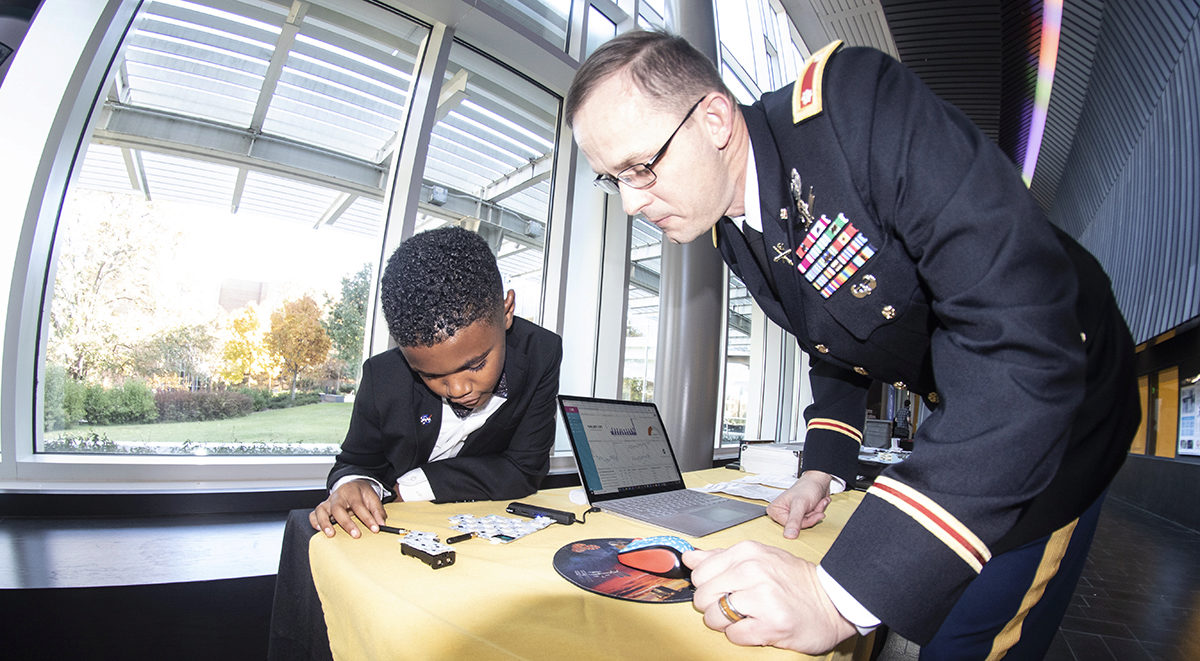 |
| Investing in the Future. Right now, 10-year-old Christopher Lyons of Melbourne, Florida, is 'into' gaming, coding, and...space, of course. At the Symposium on Space Innovations, Christopher took a minute to explain a miniature weather satellite to U.S. Army War College Fellow Don Brooks. (A few minutes later, Brooks was off to serve as an expert panelist for the Space Security discussion.) While these two consulted, Christopher's mom, Rhonda Lyons (CEO & Founder of NYRAD Engineering) informed us that her son's official title for the day was Chief Kid Engineer. He is part of the Hines Foundation's Continuity Model initiative, which is seeking to inspire students ages 3 to 23 to get into STEM disciplines. After speaking with this pint-sized ambassador for five minutes, we'd have to say: they picked the right guy for the job. Check out the Symposium's slideshow. |
More than 300 academics, business leaders, government officials, and aspiring astronauts converged on Georgia Tech's Marcus Nano Technology Building November 17 and 18 for the Third Annual Symposium on Space Innovations.
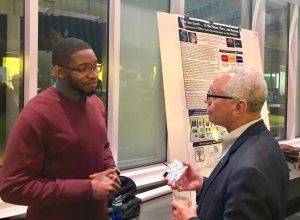 |
| AE doctoral student Olatunde Sanni, left, talking shop with former NASA administrator Charles F. Bolden, Jr. |
Sponsored by the Georgia Space Grant Consortium, the GT Center for Space Technology And Research (C-STAR), GTRI, GT's Institute for Materials, and several aerospace businesses, the 2019 Symposium highlighted recent innovations in space science and technologies through a combination of technical presentations, panel discussions, guest speakers, and poster presentations.
"This year, there has been a lot of interest in lunar exploration, our return to the moon by 2024," said conference organizer Dr. W. Jud Ready, deputy director at GT's Institute for Materials. "To me the technological questions have not been nearly as exciting as the biological challenges because, really, we're not talking about going to the moon for a week, this time around; we're talking about living there for several months at a time. How do you do that? We have people who are talking about that.
Among other things, Ready pointed out, long-term moon habitation will force scientists to tackle cosmic radiation issues, gamma cosmic ray exposure, and dust adherence.
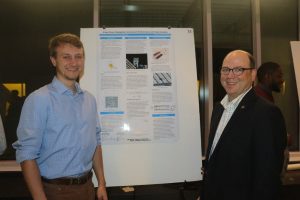 |
| Prof. E. Glenn Lightsey with one of his students, Jacob Payne, at the poster competition. |
"The dust on the moon is not like dust you have in your house. It's razor sharp and, when it gets stuck in your space suit, it can cause it to tear."
Headlining the event was former NASA Administrator and retired Marine Corps General Charles F. Bolden, Jr., whose keynote talk, "The Diplomatic Power of Space Exploration" reminded listeners that building the space program of tomorrow is both an awesome power and an awesome responsibility.
"There are not a lot of things in the world that captivate people everywhere you go, that will make people who don't like each other to sit in a room and talk with one another," he said. "That's the power of space. There is a universal infatuation with space exploration. It behooves us to use that to make the world a better place."
Pointing to an aerial view of the Earth, Bolden urged the audience to not let territorial boundaries get in the way of the excitement that space exploration brings to everyone.
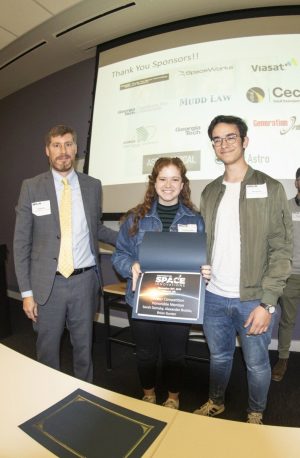 |
| Conference organizer Dr. Jud Ready, left, delivers an honorable mention award to AE students Sarah Demsky and Alex Bustos for their poster "Design and Manufacturing of a Semi-Autonomous CubeSat Inflation Tank" |
"Do you care if you got to this conference in an Uber, on a bike, or in your own car? Of course you don't. Remember that. It doesn't matter how we get into space. There will always be an American and a Russian on the ISS. There always has been."
For students, a highlight of the 2019 conference was the poster presentation reception, which was held Sunday, November 17.
Judges conceded that there were too many deserving presentations for them to choose just one for the top honor. Splitting the $500 stipend for first place were four teams of students who presented posters under the theme Vertical Entry Robot for Navigating Europa (VERNE). Those teams were (1) System and Mission Design (Frances Bryson, Mohamed Nassif, Sam Rapoport, Phillip Szot, Yashvardhan Tomar, Bridget Wiley); (2) Drill Design Considerations for Use on Europa (Jose Andrade, Ben Breer, Frances Bryson, Nathan Daniel, Mohamed Nassif, Yashvardhan Tomar) (3) VERNE Thermal Management System (Sam Rapoport, Elizabeth Spiers, Bridget Wiley); (4) Science System for VERNE (Chase Chivers, Ashley Hanna, Chinmayee Govinda Raj, Elizabeth Spiers, Yashvardhan Tomar).
Three other teams received honorable mentions for their posters.
For faculty, the symposium was a welcomed opportunity to stand back and see what others are doing -- in industry, in the government, and even at another Georgia Tech school or center.
"An exciting development this year is the addition of a fairly large contingent of astrobiology experts to the mix," said Prof. E. Glenn Lightsey, who heads up C-STAR and AE's Space System Design Lab (SSDL). "The thing that continues to build this symposium's strength is its emphasis on cross-disciplinary collaboration. There is really a sense that everyone at Tech is collaborating to push the discipline forward. And you really see that at this symposium."
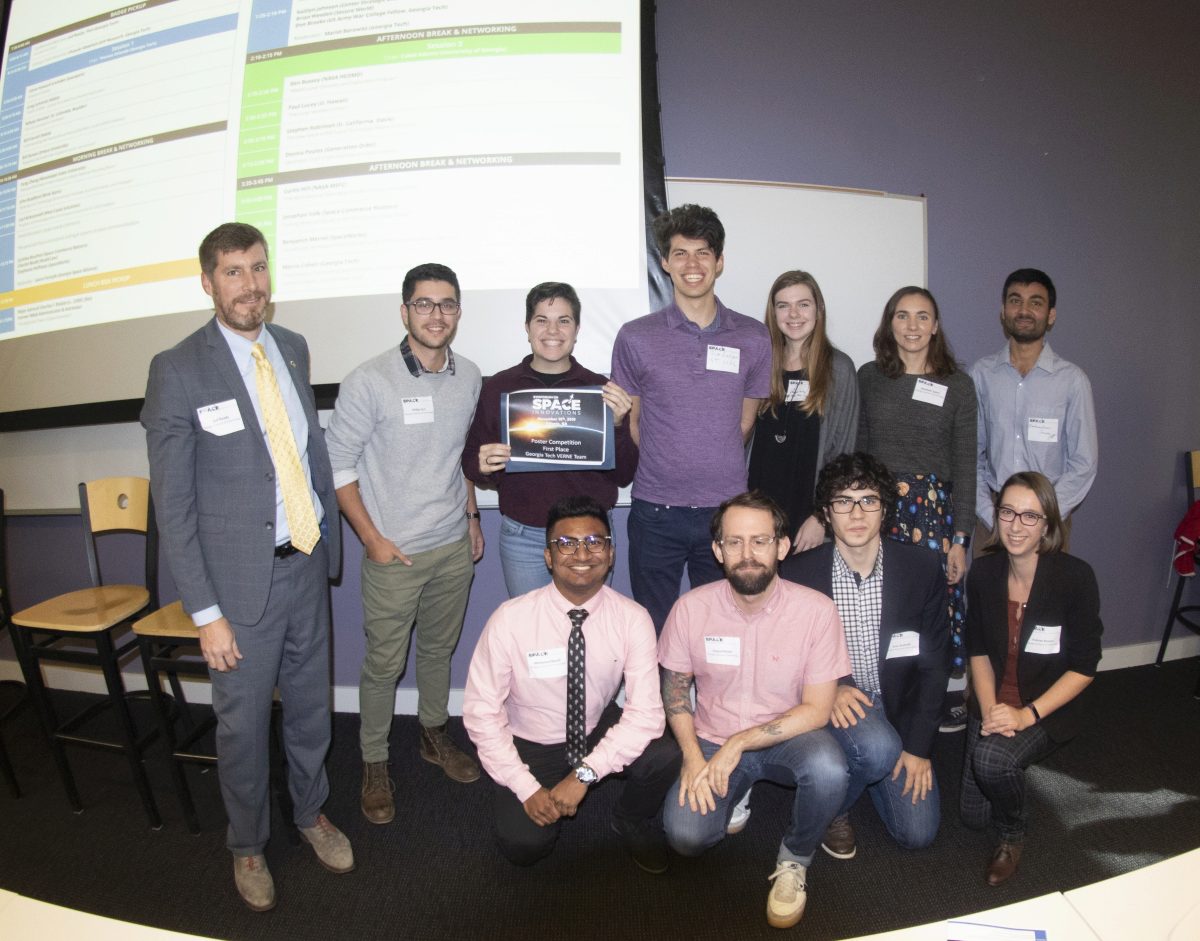 |
| Best Poster. All four of the teams that presented research under the theme "Vertical Entry Robot for Navigating Europa (VERNE)" received the top award for their work. They are seen here with Dr. Jud Ready. |